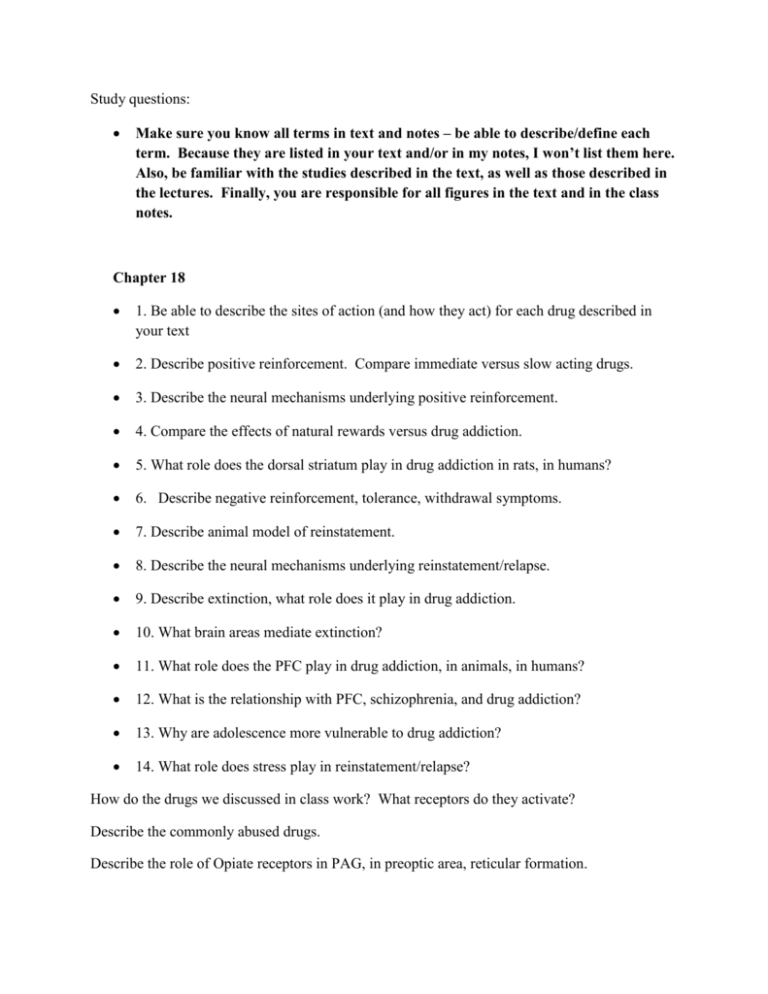Study questions ch 1..
advertisement

Study questions: Make sure you know all terms in text and notes – be able to describe/define each term. Because they are listed in your text and/or in my notes, I won’t list them here. Also, be familiar with the studies described in the text, as well as those described in the lectures. Finally, you are responsible for all figures in the text and in the class notes. Chapter 18 1. Be able to describe the sites of action (and how they act) for each drug described in your text 2. Describe positive reinforcement. Compare immediate versus slow acting drugs. 3. Describe the neural mechanisms underlying positive reinforcement. 4. Compare the effects of natural rewards versus drug addiction. 5. What role does the dorsal striatum play in drug addiction in rats, in humans? 6. Describe negative reinforcement, tolerance, withdrawal symptoms. 7. Describe animal model of reinstatement. 8. Describe the neural mechanisms underlying reinstatement/relapse. 9. Describe extinction, what role does it play in drug addiction. 10. What brain areas mediate extinction? 11. What role does the PFC play in drug addiction, in animals, in humans? 12. What is the relationship with PFC, schizophrenia, and drug addiction? 13. Why are adolescence more vulnerable to drug addiction? 14. What role does stress play in reinstatement/relapse? How do the drugs we discussed in class work? What receptors do they activate? Describe the commonly abused drugs. Describe the role of Opiate receptors in PAG, in preoptic area, reticular formation. What is Antagonist-precipitated withdrawal? What role does the LC have in opiate tolerance and withdrawal? What are the side effects of cocaine? Dopamine release in the NA is critical for drug addiction – discuss. What role does the insula play in nicotine addiction? What role do cannabinoids play in nicotine addiction? Why do people often gain weight when they stop smoking? Describe the effects of alcohol on the brain. Compare the role of NMDA receptors and GABA receptors in alcohol addiction. Describe the role of NMDA receptors in alcohol withdrawal. What role do opioids have in alcohol addiction? What effects does cannabis have on behavior, hippocampal function, learning? Describe therapies for drug addiction (opioid, cocaine, nicotine, alcohol). Opiate receptors in NAC and VTA Chapter 9 Describe the stages of sleep What are the 3 Standard Psychophysiological Measures of Sleep? Describe REM sleep, SWS What role does REM play in dreaming? Compare REM and SWS. Mental activity occurs during both REM and slow-wave sleep – discuss. Describe the different types of sleep disorders. What are the symptoms of narcolepsy? What causes narcolepsy? Describe the treatments for narcolpsy. What is REM sleep disorder? Describe disorders associated with SWS. What is the function of SWS? What is the function of REM sleep? What are the effects of sleep deprivation? Describe the role of SWS in learning, REM sleep in learning. Describe the role of adenosine in sleep. Describe the neurochemicals involved in arousal. What controls activity of arousal neurons? Describe the flip-flop mechanism in SWS. Describe the role of orexin in control of SWS. Describe the neural control of REM sleep. Where are the REM-on and REM-off regions located? Describe the REM flip/flop – what controls it? Know all figures How does degeneration of orexin cause narcoplepsy? Describe the outputs of the REM-on region. Describe the role of the SCN in our biological clock. What is melanopsin, how is it involved in biological clock? Describe the role of the pineal gland in the establishment of biological clocks. Describe the effects of changes in circadian rhythms. What is the best treatment?







